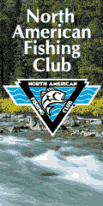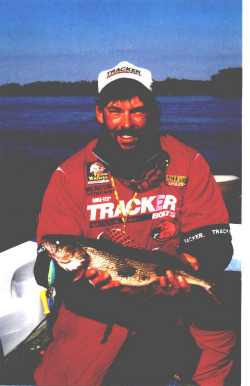
|
|||


Look as Sharp as your hooks Click here for the latest in Walleyes Inc. outdoor wear Promotional Team Favorites Lodging food and more |
By DANIEL VINOVICH
HIGH & MUDDY! That is the quote that sends chills down the spine of some of the best tournament fishermen and guides across the state. Unfortunately, that is a phrase that is a common one when a conversation sparks up about the spring sauger runs on the Illinois River. The spring runs on the Illinois River have become, in my opinion, one of the best seasonal patterns this state has to offer. Unfortunately, along with the yearly March sauger runs, comes the yearly snow melt run-off and the spring rains. It does not take much rain to turn 20 inches of water clarity in the river into something that looks like it came out of Willie Wonka’s Chocolate Factory. Fortunately, for us, the river run sauger can adapt their feeding habits to meet the existing or, should I say, daily river fluctuations. By no means is this going to be a how to type of an article on how to beat raging flood waters, but rather a few tips on how to locate sauger in less than perfect conditions. One of the best tips I can give you when high water is the name of the
game is to access the river conditions before going or at the ramp.
No fish is worth your life or the lives of your buddies. Strong currents
and floating debris can spell trouble at the drop of a hat. So look
at the water and make the call. If you think the water is fishable,
then fish. If not, maybe a couple of cups of coffee and swapping
a few lies might be the order of the day.
The second task is to break down the area we are going to fish. Where are our baits going to be the most visible? Are they going to be visible in 20 feet of water? Maybe we should go shallow where we are going to get the most light penetration. Shallow is the answer. So we have locked down an area and the depth we our going to fish. Let’s look at what else a spot needs to hold fish. Current breaks or obstructions in the water is our next likely holding area. These areas are important in normal conditions, so you can see how important it will be to a spot in high water. The force of the water hitting the obstruction will create eddies or slack where the fish can hold without too much effort on their part. This slack water also provides a haven for baitfish also looking to get out of the strong currents. Bridge pilings, barge tie-offs, the back sides of islands, or fishing sharp turns in the river where the current will be slowed and somewhat cleaned as it passes through shoreline vegetation such as weeds and trees will all offer good current breaks in a river system and are prime areas to hit. The baits we use can also make the difference in putting fish in the boat. Your choices are endless. Let’s look at putting as many of the walleye or sauger means to locate and find food in our favor. Sound, smell, vibration, and sight all play a major roll in locating prey. Sound can play a major role, considering sound waves carry 5 times greater in water than air. Rattles in or on your baits will help fish locate your bait. Rattles are a standby in most of today’s crankbaits. Jigs, on the other hand, which work mainly on sight, also have incorporated rattles into their fish catching ability. WAZP tackle makes a jig that I like to use in these conditions. It has a brass rattle molded into the jig which has a much louder rattle than some of the other glass or plastic rattles. Sense of smell is another important sense to consider. Walleyes, salmon and other types of fish have an acute sense of smell. This sense of smell helps not only to guide them to their spawning areas, but also aids in locating prey. For this reason, I always use scent or tip with live bait on all of my sauger and walleye presentations. One type of bait always comes to mind when we talk about vibration in the water, and that is a blade bait. Blade baits are a hot commodity when it comes to taking fish in dirty water. The high vibration is created by ripping the bait with short snaps of the rod tip. Water passes across the sides of the bait, causing it to shudder and, as I call it, thump. By keeping up this thumping vibration, it helps fish home in on the bait through the use of its lateral lines. The final and, as we have discussed earlier, the most important is sight. Along with water clarity and light penetration, color can play a major role in helping the fish see your bait. I stick to the florescent colors, such as yellow chartreuse, neon pink, and blaze orange, even though these colors are highly visible. Remember, all color looses its ability to attract fish as the depth gets greater. By using these tips and everything we can to put the odds in our favor the next time we hit the water in less than desirable conditions, might be a little more fishermen friendly. For guided spring trips on the Illinois River or Powerton Lake, you can call Predator Guide Service at 309-347-1728 or by e-mail at trolling@mtco.com. For added tips and ways to better catch walleyes, you can visit my web site at www.walleyesinc.com, along with other tips from some of the top anglers on the water. For Guided Trips call Predator Guide Service, 309-347-1728, or e-mail me at trolling@mtco.com. If you have a chance, you can catch me doing seminars at the following sport shows. So come out and say hello. Maybe you can bring me some ideas on where you would like to see us film for the upcoming 2002 season on Illinois Outdoors. E-mail Dan at trolling@mtco.com Fish Clix Banner Exchange Please visit these site sponsors |
||
|---|---|---|---|
